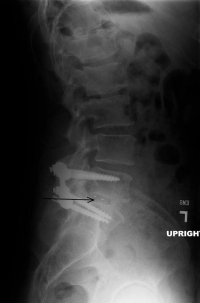The full recovery from lumbar fusion takes about 6 months before you can go out and conquer or become aggressive in your sport. Healing is split into 2 specific three month blocks. The first three months are important for a “quiet back”. This means the focus is for the back to get temporarily inflexible. This is the period when the bone cells are growing and laying down their protein matrix, the foundation for the calcium crystals that make up the bone of the fusion.
The second 3 month period is to regain the normal motion of the back.
The first 3 month period is split up into two 6 week increments. The first six weeks is the immediate recovery phase. Your incision heals within the first two weeks. You are also recovering from the affects of surgery. You will be fatigued. It is like the fatigue felt the day after running a marathon but may last up to 3 weeks. Pain medication is used and can be fatiguing by itself. Constipation occurs from these medications and use of tricks for regular bowel movements is important. You learn how to handle yourself in small maneuvers such as getting into and out of bed and how to take a shower comfortably.
Driving can be started as soon as the 3 point test is passed (see section on when to start driving).
Walking is the cornerstone exercise during the first six to promote healing and is encouraged. Walking short distances and repeating laps in the beginning is a preferable. If you walk away from your home soon after surgery let’s say ½ mile and then are too fatigued to walk the ½ mile return, this creates a dilemma. I use to encourage walking as much as tolerated but when one patient walked 8 miles the day upon discharge from the hospital; I had to revise my advice to use more common sense and moderation
Self-regulated exercise during the first 6 weeks is helpful to speed recovery. You can get on a stationary bike as long as it is mostly upright (you don’t want to be on a trainer bent too forward so move the handlebar to the upright position). You can get on a treadmill to walk or even an elliptical as long as your arms are stationary (don’t use the movable arm handles as this promotes rotation which should be avoided in the first 3 months).
Activities that are discouraged during the first three months are bike riding (falling can delay or prevent recovery), weight lifting and running activities such as tennis basketball and such.
Medications play an important role in recovery. Medications to avoid during the first three months include all forms of aspirin and nonsteroidal anti-inflammatory (NSAIDs) like motrin, ibuprofen, alieve, naprosyn, celebrex and all others. As the names imply, these are all anti-inflammatories and bone healing starts with the inflammation phase. These medications interfere with this important phase and need to be eliminated (unless specifically recommended by your doctor).
Pain medications are important to use during the initial recovery phase. These are all narcotics and as such, can cause slowing of mentation (thoughts) and constipation. Most likely, you will be given a time released pain medication like Oxycontin or MS contin and one short acting medication for break through pain. A muscle relaxant may also be used for the “muscle ache” that can go along with surgery in the immediate period.
To understand why recovery has certain time parameters, an understanding of the physiology or what is happening on the microscopic level leads to understanding of why certain rules need to be followed. Bone cells grow with immobility. The less motion of the segment that is healing, the quicker will a solid fusion take place.
A good example is the famous lower leg (tibia) fracture. Years before, we use to place these fractures in a long leg cast. You may be old enough to remember friends walking with crutches and a cast that went from their foot up to the top of their thigh. These casts might have been worn for 6 months and the healing rate was limited. We learned that if we surgically place a thick titanium rod down the center of the bone of the tibia, most of these would go on to heal in 3 months. It turns out that rigidly immobilizing the bone promoted quicker and more through healing.
We learned the same thing with spinal fusion. Immobilization of the spinal segment is paramount to promote healing. There are two things that immobilize the spine. One is instrumentation and the other is arresting motion through activity restriction. The screws and rods placed into the spine are a temporary fixation to prevent motion and allow healing. After the fusion is completed, they are superfluous (but normally stay in after surgery as there is no need to remove them).
Activity restriction is the other key and this is under direct patient control. For the first three months, “BLT” needs to be restricted. (That’s bending, lifting and twisting). There are techniques that are taught to patients while recovering in the hospital to compensate for these restrictions. Devices are used that are helpful in reaching and lifting. Lifting restrictions for the first 4 weeks include no more than 10 pounds.
With the latest techniques, fusion surgery takes about 6 months from the date of surgery to full fusion. This time period can vary from 4 months to rarely about one year but for most patients, a solid fusion will be achieved in 6 months. Full fusion normally means returning to such sports as biking, golf, tennis or running (if appropriate) or undertaking professional sports.

